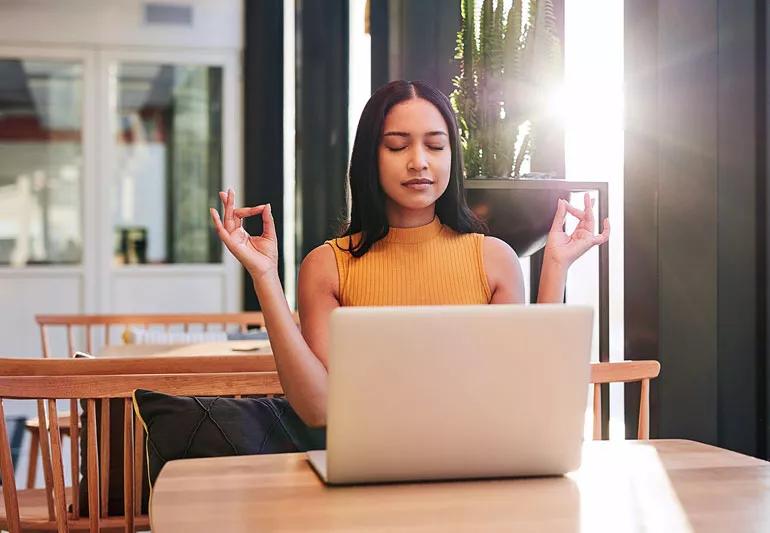Easy ways to embrace this beneficial practice

It’s easy to get caught up in feeling worried about things out of your control. That could be something happening in your life in the near future. Or maybe you’re regretting something you said last week.
Advertisement
Cleveland Clinic is a non-profit academic medical center. Advertising on our site helps support our mission. We do not endorse non-Cleveland Clinic products or services. Policy
Practicing mindfulness is one way to address this anxiety and stay focused on the present.
“Mindfulness is about being in the moment,” says wellness and breast medicine specialist Roxanne B. Sukol, MD. “If you’re spending all your time worrying about the future or thinking about whether you should have done something differently in the past, it’s almost like you’re missing your life.”
You can think of mindfulness as engaged relaxation. Luckily, it doesn’t take much to feel a positive impact. In fact, you can start practicing mindfulness right now.
“Think about how going for a great walk makes you feel somehow brighter, or empowered,” says Dr. Sukol.
In addition to helping with stress relief, practicing mindfulness can help you feel calmer and more relaxed.
Studies have also shown that breathing better and more deeply — both things that occur in mindfulness practice — can improve your overall health. For example, more oxygen flowing to your brain is always a good thing and can improve your concentration and ability to solve problems.
Unsurprisingly, mindfulness and meditation are closely linked.
Dr. Sukol saw parallels herself in her own meditation practice over time. “It took a long time, a couple of years really, but I began to understand how it was helping me,” she says. “I really did feel different — more grounded, more relaxed, more measured, less reactive.”
Advertisement
One of the most accessible ways to practice mindfulness is through meditation. This is easier than you might think. “Everyone thinks you have to commit to meditate for 10, 15 or 20 minutes,” says Dr. Sukol. “But I usually recommend starting with a one-minute meditation.”
Where you do this one-minute meditation varies — and there’s no right or wrong place to practice as long as it’s relatively quiet and you’re unlikely to be disturbed. “I suggest that people consider meditating when they get to work, or they reach their first destination of the day,” says Dr. Sukol. “Once you park, if you’re in your car, you can drop your keys in your lap, and then close your eyes.”
The next steps are simple: Breathe in for five seconds, and then breathe out for five seconds. “That’s your warm up,” says Dr. Sukol. “Now do that five more times. That’s it. That’s one-minute meditation. When offered this option, most of my patients say, ‘I could do that.’”
A one-minute meditation can have a long-term impact. In fact, don’t be surprised if you find yourself starting to meditate for longer periods of time. That happened to Dr. Sukol. “I kept doing my one-minute meditation, but sometimes it turned into two,” she says. “And then, one day, I looked at the clock and six minutes had gone by. Now, I meditate for probably 10 or 15 minutes every morning, but if I’m in a hurry, I can always do a one-minute meditation if necessary.”
It may not seem like a lot, but it adds up. A minute of meditation every day equals 30 minutes in a month, and six hours in a year. That’s a lot more than zero.
In addition to meditation, here are other tips you can use to start practicing mindfulness.
Picking and choosing from some of the above tips can help you start practicing mindfulness. If you’re not feeling drawn to a particular activity, don’t try it. The goal is not to do everything. It’s to find something that does work for you. Maybe one tip feels better to you one day, while a more low-key option suits your energy level at another time.
Getting to a point where you can stay focused in the present takes practice. However, there’s no right (or wrong) way to practice mindfulness. The trick, at least at first, is to set realistic goals.
Advertisement
“It’s important to find something that works for you,” says Dr. Sukol. “Take very tiny steps and make your goals accessible to guarantee that you’ll be successful. When we set ourselves up for failure, we end up not moving in the direction we were hoping. It chips away at our sense of self — and then we don’t want to do it anymore.”
Of course, remaining in the moment can be difficult. Our world is full of distractions. “And then we feel bad about the fact that we got distracted,” Dr. Sukol says. “When we try again, a little kick of ‘I failed’ registers in our brain.”
Paying attention to the rhythms of your breathing can also help you develop focus and stay centered. In fact, the message that helps us remain grounded in the present is “returning to the breath,” says Dr. Sukol. “The breath is like a proxy for the present. Every time you find yourself thinking about other concerns, this is your opportunity to return to the breath. It becomes part of the rhythm.”
Practice makes progress, she adds — and perfection is the enemy of progress. “Some days, you will stay with the breath more easily than other days. At other times, you may feel so distracted that you barely feel as if you were meditating. But it doesn’t matter. It’s all about practicing.”
Advertisement
“The purpose of meditation is simply to meditate. That’s all,” she continues. “Every time your brain generates another issue to think about, your only task is to notice it, allow it to pass without judgment, and then return to the breath. This is the goal of a meditation practice.”
Above all, be kind to yourself. If mindfulness isn’t working out at the moment, tomorrow is always a new day.
“We are living in an environment that takes pleasure in discomfort,” notes Dr. Sukol. “People brag about being sleep-deprived, for example, or about not having eaten a nourishing meal in days. But that’s not good for you, your family or your co-workers.
“Not only is it OK to be kind to yourself, to practice self-compassion and to go out of your way to do things that are good for you — it’s imperative,” she adds. “And not just for you personally, but for all the people who rely on and care about you.”
Advertisement
Learn more about our editorial process.
Advertisement

Breathing, exercise, mindfulness and more can help you unwind and step away from your stress

From breath meditation to yoga nidra, all types of meditation aim to help you feel calmer, more relaxed and present

Different types of yoga poses, meditation and breathwork may help you feel more emotionally balanced

Sensory deprivation therapy can help relieve stress, improve sleep and decrease physical pain

You don’t need to have years of experience to reap the rewards of meditation — with benefits for your whole body, you only need a couple minutes to get started

While walking, be mindful of your body, your mind, your place in the world and all five of your senses as you pave a path forward, one step at a time

Thunder, waterfalls and heavy rain — these low-frequency sounds might help cancel out disruptive noises and thoughts

Immersing yourself in nature can improve both your mental and physical health

Start having sex about 72 hours before ovulation, then at least every other day during your fertile window

Attachment theory suggests that your earliest relationships shape connections throughout your life

It isn’t a recognized mental health disorder, but research shows that problematic social media use can negatively affect your mental health, self-esteem and sleep